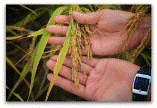Plant Pathology, Department of

Fungal Molecular Plant-Microbe Interactions
Date of this Version
12-2011
Document Type
Article
Citation
PLoS Pathology (2011) 7(12): e1002441
doi: 10.1371/journal.ppat.1002441
Abstract
RNA-binding proteins play a central role in post-transcriptional mechanisms that control gene expression. Identification of novel RNA-binding proteins in fungi is essential to unravel post-transcriptional networks and cellular processes that confer identity to the fungal kingdom. Here, we carried out the functional characterisation of the filamentous fungus-specific RNAbinding protein RBP35 required for full virulence and development in the rice blast fungus. RBP35 contains an N-terminal RNA recognition motif (RRM) and six Arg-Gly-Gly tripeptide repeats. Immunoblots identified two RBP35 protein isoforms that show a steady-state nuclear localisation and bind RNA in vitro. RBP35 coimmunoprecipitates in vivo with Cleavage Factor I (CFI) 25 kDa, a highly conserved protein involved in polyA site recognition and cleavage of pre-mRNAs. Several targets of RBP35 have been identified using transcriptomics including 14-3-3 pre-mRNA, an important integrator of environmental signals. In Magnaporthe oryzae, RBP35 is not essential for viability but regulates the length of 3'UTRs of transcripts with developmental and virulence-associated functions. The Δrbp35 mutant is affected in the TOR (target of rapamycin) signaling pathway showing significant changes in nitrogen metabolism and protein secretion. The lack of clear RBP35 orthologues in yeast, plants and animals indicates that RBP35 is a novel auxiliary protein of the polyadenylation machinery of filamentous fungi. Our data demonstrate that RBP35 is the fungal equivalent of metazoan CFI 68 kDa and suggest the existence of 3'end processing mechanisms exclusive to the fungal kingdom.


Comments
Copyright 2011, the authors. Used by permission.